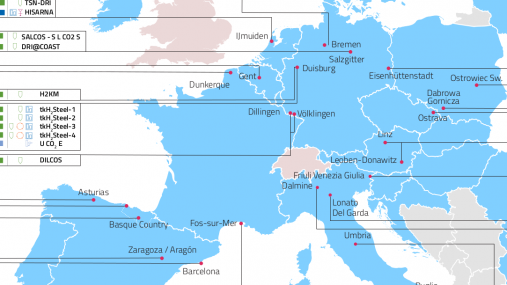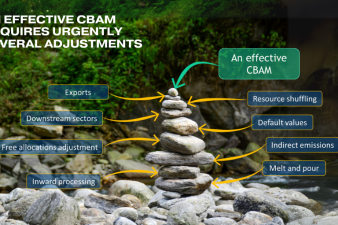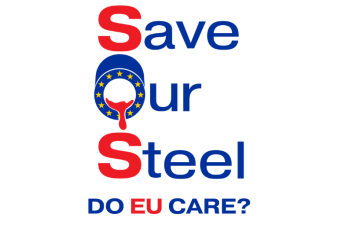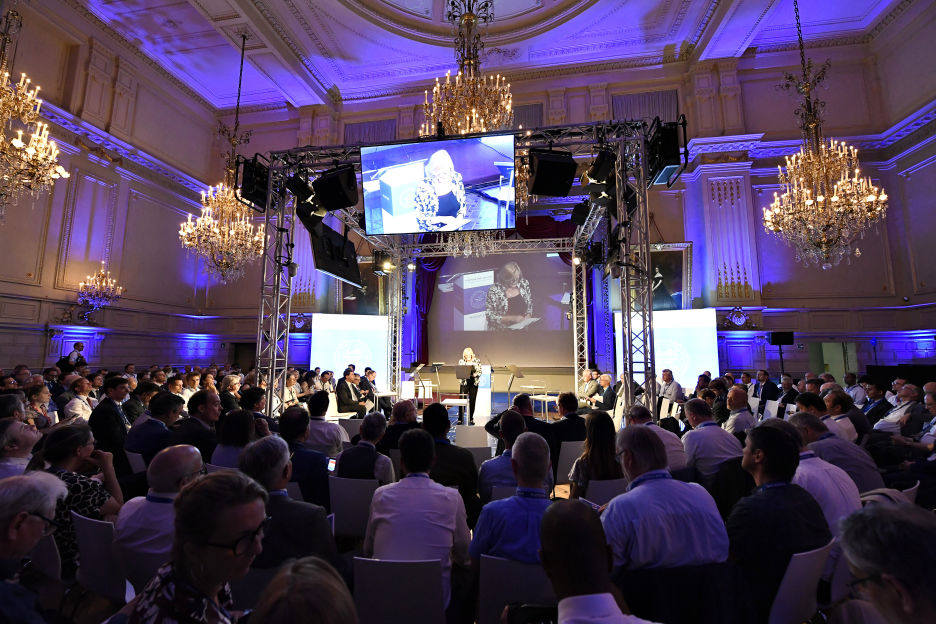





(not included in SCU, CDA or CE)
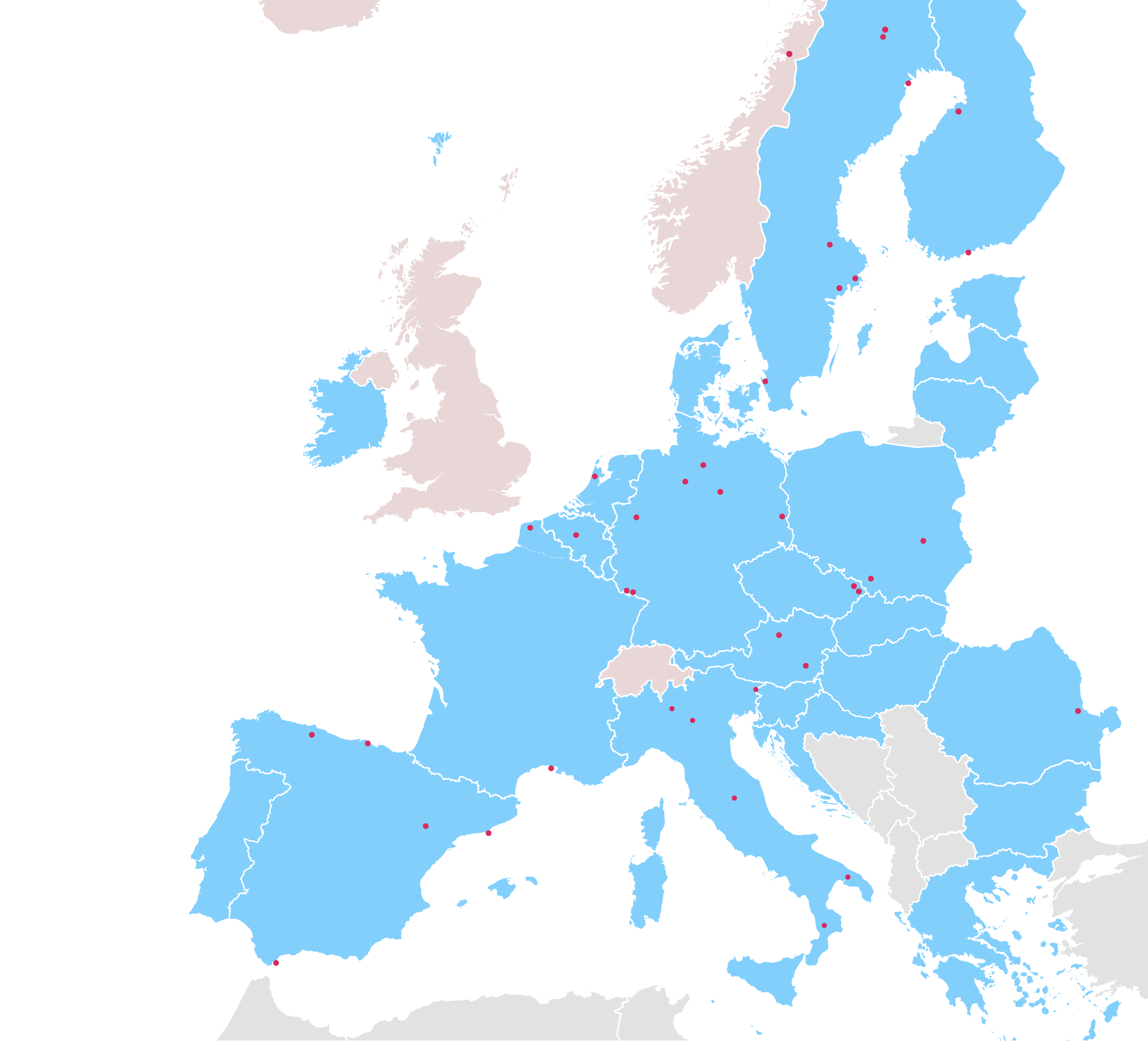
Mo i Rana
Gällivare
Norbotten
Luleå
Raahe
Hofors
Helsinki
Stockholm
Oxelösung
Höganäs
Hamburg
Bremen
IJmuiden
Salzgitter
Eisenhüttenstadt
Duisburg
Gent
Ostrowiec Sw.
Dunkerque
Dabrowa
Gornicza
Ostrava
Trinec
Dillingen
Völklingen
Linz
Leoben-Donawitz
Friuli
Venezia Giulia
Lonato
Del Garda
Dalmine
Umbria
Puglia
Calabria
Asturias
Sestao
Fos-sur-Mer
Zaragoza / Aragón
Galati
Tallinn
Copenhagen
Edinburgh
Dublin
Manchester
Cork
London
Berlin
Amsterdam
Warsaw
Gdansk
Krakow
Prague
Leipzig
Frankfurt
Paris
Munich
Vienna
Bratislava
Budapest
Ljubljana
Venice
Zaragoza
Milan
Athens
Rome
Palermo
Lyon
Marseille
Bordeaux
Valencia
 H2 NORWAY (CELSA Nordic) / Mo i Rana
H2 NORWAY (CELSA Nordic) / Mo i Rana
Use of hydrogen as a 100 % fuel source at our Rolling mill.
STARTING YEAR:
Before 2030
 HYBRIT (TRANSITION) (SSAB) / Gällivare
HYBRIT (TRANSITION) (SSAB) / Gällivare
HYBRIT (LKAB, SSAB and Vattenfall) demonstration plant for fossil-free hydrogen production and H2 reduced iron sponge production (1.3 million tonnes).
STARTING YEAR:
Before 2030
 HYBRIT (TRANSITION) (SSAB) / Raahe
HYBRIT (TRANSITION) (SSAB) / Raahe
Transition, based on HYBRIT technology, from blast furnace to mini-mills, with electric arc furnaces and rolling mills.
STARTING YEAR:
Before 2030
 HYBRIT (TRANSITION) (SSAB) / Oxelösung
HYBRIT (TRANSITION) (SSAB) / Oxelösung
Transition, based on HYBRIT technology, from blast furnace to electric arc furnace.
STARTING YEAR:
Before 2030
 H2 INITIATIVE (LKAB) / Norbotten
H2 INITIATIVE (LKAB) / Norbotten
IPCEI project for industrial demonstration of hydrogen production, hydrogen-gas heating of pelletizing plants, direct reduction of iron and use of hydrogen in production of fertilizers and REE concentrate
- A new world standard for mining. Through digitization, automation, electrification, new ways of working and carbon dioxide free production, we are setting a new world standard for mining.
- Carbon dioxide-free sponge iron with hydrogen technology. Through the shift from iron ore pellets to carbon dioxide-free sponge iron, we are taking an important step forward in the value chain, increasing the value of our products while at the same time giving our customers direct access to carbon dioxide-free iron for steel production.
- With fossil-free technology, we will extract strategically important rare earth metals and phosphorus for mineral fertilizers from the mines' current residual products.
STARTING YEAR:
Before 2030
 THE HYBRIT INITIATIVE (SSAB) / Luleå
THE HYBRIT INITIATIVE (SSAB) / Luleå
THE HYBRIT INITIATIVE - H2 direct reduction pilot plant and hydrogen storage pilot (SSAB) / Luleå
SSAB, LKAB and Vattenfall have started HYBRIT (Hydrogen Breakthrough Ironmaking Technology) to develop a fossil-free value chain for iron and steel production using fossil-free electricity and hydrogen.
Pilot plant for hydrogen production and direct reduction in operation. In June 2021, the three companies were able to showcase the world’s first hydrogen-reduced sponge iron produced at HYBRIT’s pilot plant in Luleå.
This first sponge iron has since been used to produce the first steel made with this breakthrough technology.
Hydrogen storage pilot to be operational in 2022.
STARTING YEAR:
Before 2030
 ICOS (OVAKO) / Hofors
ICOS (OVAKO) / Hofors
Improved circularity of steel (ICOS)
Establishing a cost-efficient way of removing Cu from scrap when refining steel
STARTING YEAR:
Before 2030

 On-Site EFHS (OVAKO) / Stockholm, Helsinki
On-Site EFHS (OVAKO) / Stockholm, Helsinki
On-site electrolysis for heating steel (On-Site EFHS)
Proving a world-leading cost-efficiency in eliminating CO2 when heating steel for hot-forming. Showing the way for world-leading cost-efficiency in refuelling of fuel cell based long haul trucking. Proving true electricity flexibilty with regulations possible down to 1 second intervals.
STARTING YEAR:
Before 2030
 PROBIOSTÅL (Höganäs) / Höganäs
PROBIOSTÅL (Höganäs) / Höganäs
Biomass gasification for reduction of renewable fuels in steel industry
 PEP. Challenge (Höganäs) / Höganäs
PEP. Challenge (Höganäs) / Höganäs
Replacement of fossil coal with renewable coal
STARTING YEAR:
Before 2030
 CORALIS (Höganäs) / Höganäs
CORALIS (Höganäs) / Höganäs
Waste heat and CO2 for food production in green houses
STARTING YEAR:
Before 2030
 DRIBE2 (ArcelorMittal) / Bremen
DRIBE2 (ArcelorMittal) / Bremen
Implement innovative DRI route to reduce carbon footprint
STARTING YEAR:
Before 2030
 HH CDA (ArcelorMittal) / Hamburg
HH CDA (ArcelorMittal) / Hamburg
Implement innovative DRI route to reduce carbon footprint
STARTING YEAR:
before 2030
 SALCOS (Salzgitter AG) / Salzgitter
SALCOS (Salzgitter AG) / Salzgitter
SALCOS - Salzgitter Low CO2 Steelmaking:
Direct avoidance of CO2 formation in metallurgical processes by the replacement of carbon by (electrolytically produced) hydrogen as reducing agent in iron ore reduction. Use of already established (direct reduction plant (DRP) with natural gas), electric arc furnace (EAF) and novel (hydrogen production and DRP-EAF integration into existing plant) technologies is leading to a gradual reduction of CO2 emissions up to 95% already in 2033. Step I, the replacement of one blast furnace with one direct reduction plant, one electric arc furnace and an electrolyzer, leads to a CO2 reduction of 30 % compared to conventional route in Salzgitter and can start operation already in early 2026 (>2 Mio t CO2/a).
STARTING YEAR:
Before 2030
 DRI@Coast (Salzgitter AG) / Salzgitter
DRI@Coast (Salzgitter AG) / Salzgitter
Direct avoidance of CO2 formation in metallurgical processes by the replacement of carbon by (electrolytically produced) hydrogen as reducing agent in iron ore reduction. Use of already established (direct reduction plant (DRP) with natural gas), electric arc furnace (EAF) and novel (hydrogen production and DRP-EAF integration into existing plant) technologies is leading to a gradual reduction of CO2 emissions up to 95%. Stage I, the replacement of one blast furnace with one direct reduction plant, one electric arc furnace and an electrolyzer, leads to a CO2 reduction of 30 % compared to conventional route in Salzgitter and can start operation already in 2026 (>2 Mio t CO2/a).
Unlike the SALCOS project, the DRP is to be built in a coastal location close to offshore wind capacity and proximity to a deep-sea port.
STARTING YEAR:
Before 2030
 DRIBE2 (ArcelorMittal) / Eisenhüttenstadt
DRIBE2 (ArcelorMittal) / Eisenhüttenstadt
Implement innovative DRI route to reduce carbon footprint
STARTING YEAR:
Before 2030
 H2KM (Thyssenkrupp Steel Europe) / Duisburg
H2KM (Thyssenkrupp Steel Europe) / Duisburg
Stepwise sustainable transformation from conventional Blast Furnace / Basic Oxygen Furnace steelmaking to hydrogen-based Direct Reduction Plant / Electric Arc Furnace steelmaking, with view of at least 30% CO2 emissions reduction by 2025 (compared to 2014) and ultimately achieving climate neutrality by 2045.
STARTING YEAR:
Before 2030
 tkH2Steel-1 (Thyssenkrupp Steel Europe) / Duisburg
tkH2Steel-1 (Thyssenkrupp Steel Europe) / Duisburg
1st direct reduction plant with Melting Unit
STARTING YEAR:
Before 2030
 tkH2Steel-2 (Thyssenkrupp Steel Europe) / Duisburg
tkH2Steel-2 (Thyssenkrupp Steel Europe) / Duisburg
2nd direct reduction plant with Melting Unit
STARTING YEAR:
Before 2030
 tkH2Steel-3 (Thyssenkrupp Steel Europe) / Duisburg
tkH2Steel-3 (Thyssenkrupp Steel Europe) / Duisburg
3rd direct reduction plant with Melting Unit
STARTING YEAR:
Before 2030
 tkH2Steel-4 (Thyssenkrupp Steel Europe) / Duisburg
tkH2Steel-4 (Thyssenkrupp Steel Europe) / Duisburg
4th direct reduction plant with Melting Unit
STARTING YEAR:
Before 2030
 CARBON2CHEM (Thyssenkrupp Steel Europe) / Duisburg
CARBON2CHEM (Thyssenkrupp Steel Europe) / Duisburg
Conversion of metallurgical gases into valuable base chemicals (Large scale production)
STARTING YEAR:
before 2030
 DILCOS (SHS Group) / Dillingen
DILCOS (SHS Group) / Dillingen
Stepwise integration of the new technology / substitution of Blast Furnace
STARTING YEAR:
Before 2030
 ENERGY EFFICIENT EAF (Celsa Huta Ostrowiec) / Ostrowiec Sw.
ENERGY EFFICIENT EAF (Celsa Huta Ostrowiec) / Ostrowiec Sw.
Development and implementation of novel structure of EAF
STARTING YEAR:
Before 2030
 PSWD (Celsa Huta Ostrowiec) / Ostrowiec Sw.
PSWD (Celsa Huta Ostrowiec) / Ostrowiec Sw.
Project oriented on postscrap organic waste depolymerization toward production or recycled naptha for chemical synthesis
STARTING YEAR:
Before 2030
 RENEWABLE ENERGY (Celsa Huta Ostrowiec) / Ostrowiec Sw.
RENEWABLE ENERGY (Celsa Huta Ostrowiec) / Ostrowiec Sw.
Development of renewable energy installation in form of photovoltaic and wind farms
STARTING YEAR:
Before 2030
 GAS INJECTION (ArcelorMittal) / Dabrowa Gornicza
GAS INJECTION (ArcelorMittal) / Dabrowa Gornicza
Implement innovative DRI and EAF route to reduce carbon footprint
STARTING YEAR:
Before 2030
 HyFurnace (Liberty Steel Group) / Ostrava
HyFurnace (Liberty Steel Group) / Ostrava
Replacement of the four existing tandem furnaces with two hybrid furnaces which will allow the facility to vary the mix of liquid metal and steel scrap used in the steel making process.
STARTING YEAR:
Before 2030
 GREENWERK (Trinecke zelezarny, a.s.) / Trinec
GREENWERK (Trinecke zelezarny, a.s.) / Trinec
Partial transformation of steel production towards a scrap-based EAF route with a significant decrease in fossil fuel use, energy and emission intensity, while maintaining quality.
STARTING YEAR:
-
 GREENTEC STEEL (voestalpine) / Linz / Leoben-Donawitz
GREENTEC STEEL (voestalpine) / Linz / Leoben-Donawitz
Combination of Electric Arc Furnaces (EAF), Blast Furnaces /Basic Oxygen Furnaces (BF/BOF, “integrated steelmaking”) and direct reduction (DR) technologies
STARTING YEAR:
Before 2030
 HYDRA-ITALIA - Linea 4 (RINA-CSM) / Friuli Venezia Giulia
HYDRA-ITALIA - Linea 4 (RINA-CSM) / Friuli Venezia Giulia
Reheating furnace for the subsequent lamination treatments
STARTING YEAR:
Before 2030
 H2_4_RHF (CDA) / Lonato Del Garda
H2_4_RHF (CDA) / Lonato Del Garda
Use of H2 for substitution of CH4 in Reheating Furnaces for billets
STARTING YEAR:
Before 2030
 DALMINE ZERO EMISSIONS (Dalmine SpA) / Dalmine
DALMINE ZERO EMISSIONS (Dalmine SpA) / Dalmine
Dalmine Zero Emissions project aims to replace natural gas with green hydrogen in the whole finished steel pipes production cycle, from Electric Arc Furnace (EAF) steelmaking to heat treatment processes at Dalmine plant. The target is the decarbonization of the site. Hydrogen will be locally produced by an onsite electrolysis plant powered by renewable electricity
STARTING YEAR:
Before 2030
 HYDRA-ITALIA - L3 (RINA-CSM) / Umbria
HYDRA-ITALIA - L3 (RINA-CSM) / Umbria
HYDRA-ITALIA - Linea 3: Electric furnace for melting the pre-reduced product obtained from direct reduction
STARTING YEAR:
before 2030
 HYDRA-ITALIA - L2 (RINA-CSM) / Puglia
HYDRA-ITALIA - L2 (RINA-CSM) / Puglia
HYDRA-ITALIA - Linea 2: innovative direct reduction pilot plant powered by hydrogen
STARTING YEAR:
before 2030
 HYDRA-ITALIA - L1 (RINA-CSM) / Calabria
HYDRA-ITALIA - L1 (RINA-CSM) / Calabria
HYDRA-ITALIA - Linea 1: integrated infrastructural system for the supply of green hydrogen.
STARTING YEAR:
before 2030
 TSN-DRI (Tata Steel) / IJmuiden
TSN-DRI (Tata Steel) / IJmuiden
Combination of Direct Reduction Plant (DRP) and Smelter.
STARTING YEAR:
Before 2030
 HISARNA (Tata Steel) / IJmuiden
HISARNA (Tata Steel) / IJmuiden
Innovative Ironmaking technology.
STARTING YEAR:
Before 2030
 Gent Smart Carbon (ArcelorMittal) / Gent
Gent Smart Carbon (ArcelorMittal) / Gent
Implement all available KETs to decarbonize BF route
STARTING YEAR:
Before 2030
 Gent CDA (ArcelorMittal) / Gent
Gent CDA (ArcelorMittal) / Gent
Implement innovative DRI route to reduce carbon footprint
STARTING YEAR:
Before 2030
 Gent CCU (ArcelorMittal) / Gent
Gent CCU (ArcelorMittal) / Gent
Use internal CO2 to produce fuels based on innovative solutions
STARTING YEAR:
Before 2030
 Gent CCS (ArcelorMittal) / Gent
Gent CCS (ArcelorMittal) / Gent
Use CCS solutions to sequestrate CO2
STARTING YEAR:
before 2030
 DK Smart Carbon (ArcelorMittal) / Dunkerque
DK Smart Carbon (ArcelorMittal) / Dunkerque
Implement all available KETs to decarbonize BF route
STARTING YEAR:
Before 2030
 DK CDA (ArcelorMittal) / Dunkerque
DK CDA (ArcelorMittal) / Dunkerque
Implement innovative DRI route to reduce carbon footprint
STARTING YEAR:
Before 2030
 DK CCS (ArcelorMittal) / Dunkerque
DK CCS (ArcelorMittal) / Dunkerque
Implement CCS solutions to sequestrate CO2
STARTING YEAR:
before 2030
 AST CDA (ArcelorMittal) / Asturias
AST CDA (ArcelorMittal) / Asturias
Implement innovative DRI & EAF route to reduce carbon footprint
STARTING YEAR:
Before 2030
 AST CE (ArcelorMittal) / Asturias
AST CE (ArcelorMittal) / Asturias
Use circular economy solutions for decarbonization
STARTING YEAR:
before 2030
 EAF Smart Route (ArcelorMittal) / Sestao
EAF Smart Route (ArcelorMittal) / Sestao
Use green electricity, green DRI and fossil free fuel to produce steel in EAF route
STARTING YEAR:
Before 2030
 HRSSFSG (Sidenor)
HRSSFSG (Sidenor)
Heat recovery and storage system for steam generation (HRSSFSG):
The main objective of the project is the recovery and storage of residual heat for its usage within the factory processes through the production of steam.
STARTING YEAR:
Before 2030
 CIW (Sidenor)
CIW (Sidenor)
Circularity of industrial wastes (CIW):
The main objective is the reuse and valorization of waste derived from industrial processes.
STARTING YEAR:
Before 2030
 ROGFWIF (Sidenor)
ROGFWIF (Sidenor)
Replacement of gas furnaces with induction furnaces (ROGFWIF)
Increasing productivity, optimizing consumption and reducing carbon footprint Installation of high-efficiency induction furnaces
STARTING YEAR:
Before 2030
 ROSBWEM (Sidenor)
ROSBWEM (Sidenor)
Replacement of steam boilers with electric motors (ROSBWEM)
Reduction of fossil fuel consumption and increase in energy efficiency
STARTING YEAR:
Before 2030
 HYBRID BRF (MEGASIDER ZARAGOZA SAU) / Zaragoza / Aragón
HYBRID BRF (MEGASIDER ZARAGOZA SAU) / Zaragoza / Aragón
Improving energy efficiency and CO2 emissions in the rolling mill by means of electrification and substitution of natural gas burners, and digitalization and integration of the furnace managment.
STARTING YEAR:
Before 2030
 STEELLOWCARBON (CELSA Group Spain) / Barcelona
STEELLOWCARBON (CELSA Group Spain) / Barcelona
The project aims to minimise the consumption of resources with high carbon footprint.
STARTING YEAR:
Before 2030
 CIRCULARSTEEL (CELSA Group Spain) / Barcelona
CIRCULARSTEEL (CELSA Group Spain) / Barcelona
The project aims to close the loop of the Steelmaking by products aplying CIRC principles.
STARTING YEAR:
Before 2030
 FEXI (CELSA Group Spain) / Barcelona
FEXI (CELSA Group Spain) / Barcelona
The project aims to minimise the indirect and direct CO2 emisions
STARTING YEAR:
Before 2030
 DIPSS (ACERINOX EUROPA) / Los Barrios / Andalucía
DIPSS (ACERINOX EUROPA) / Los Barrios / Andalucía
Decarbonisation (CDA) in the integral production of stainless steel (DIPSS):
Currently there are a number of processes in an integral stainless steel factory in which natural gas (NG) is used as fuel. The project aims to increase gradually the partial replacement of NG by green hydrogen (GH2)
Currently, 0% NG has been replaced by GH2.
By 2025, 12% of NG consumption is expected to be replaced by GH2.
It is intended that, by 2030, a 30% replacement of NG by GH2 will be achieved.
STARTING YEAR:
Before 2030
 Fos CDA 1 (ArcelorMittal) / Fos-sur-Mer
Fos CDA 1 (ArcelorMittal) / Fos-sur-Mer
Implement EAF route to reduce carbon footprint
STARTING YEAR:
Before 2030
 LSG-DRI (Liberty Steel Group) / Galati
LSG-DRI (Liberty Steel Group) / Galati
Development of DRI plant with intergrated EAF
STARTING YEAR:
Before 2030







